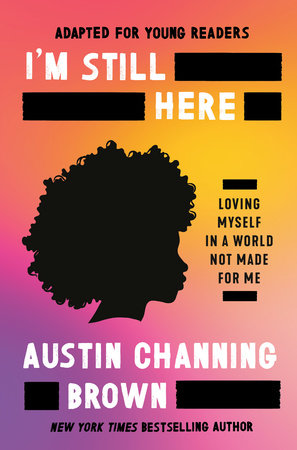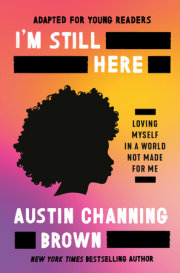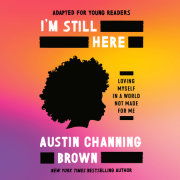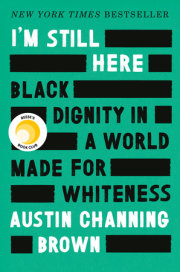Chapter 1
GROWING UP IN A BLACK GIRL’S BODYI love being a Black girl. And sometimes being a Black girl in America is hard. This whole book can be summed up in those two sentences. Book report done!
There are many reasons why it can be hard being a Black kid in America. If you are the first generation in your family to be born in America, that can be hard. If English isn’t your first language, that can be hard. If you move around a lot and have to change schools often, that can be hard. If you are multiracial, that can be hard. If you were adopted by a family who is a different race from you, that can be hard. If you are growing up in a tough neighborhood, that can be hard. There are so many situations that make being a Black kid complicated.
I grew up in a Black family, but my neighborhood and my schools were mostly white. As early as preschool, I felt different in my school, like I always stood out. And that made me curious about race. Now, don’t laugh, but I’m going to make a confession to you. As a little kid, I thought race boiled down to three basic facts:
1.My hair was different from the hair of all the white girls in my class. When white girls put their hair in a ponytail, it usually swung from side to side, swish, swish, left to right and back again. However, when I put my hair in a ponytail, it usually bounced up and down. My ponytails were determined to defy gravity with every step I took! I wasn’t sure the difference was important; it just seemed like a difference I could point to.
2.White people love cats. I mean really love them. Occasionally, kids would come to school with their arms scratched or with short, red marks streaked across their faces. When we asked, “What happened?” the answer was usually a casual wave followed by “Oh, it was just my cat.” It seemed odd that anyone would love a creature that constantly attacked them, but who was I to judge? My assumption only grew deeper when I attended my first sleepover. Kristy Canistra had two cats, and those cats had just birthed kittens. I spent the night surrounded by ten white girls chasing ten kittens, while I hid under a blanket trying to avoid all the claws!
3.I learned to never assume that our food would be the same. If macaroni and cheese was on the lunch menu, I should not expect a three-inch-tall square of baked macaroni noodles held together by a decadent mix of cheeses, egg yolk, and butter. Mac and cheese at school didn’t stand up at all. It . . . spread, as if it couldn’t wait to touch all the other food on my plate.
My point is, this race stuff was hard to figure out. And if you find yourself confused or exhausted from trying to navigate predominantly white spaces, this book is for you.
I’m going to share stories with you that might help you make sense of yourself and your world. I want to be clear, though. This book isn’t a step-by-step guide to make everyone you meet like and accept you. I don’t have any cheat codes for you. I wish I did. All I have are my stories of being a Black girl growing up surrounded by mostly white people, and how I still managed to love myself. I hope by reading my story, you are inspired to love who you are and decide for yourself how to take pride in your racial identity. I’ll share everything I can think of that helped me make sense of who I am and how I fit into the world.
Our stories won’t be exactly the same. But by the time you get to the last word on the last page, I hope you will know you are not alone when things get tricky. And I hope you will be inspired to keep falling in love with who you are.
A NAMEI love being Black. And yet, when I was a kid, white people liked to inform me that my skin color didn’t matter. Teachers. Counselors. Coaches. Principals. All were eager to assure me of my own invisibility. It was weird because they also all used the same words to explain it to me. I sometimes wondered if there was some secret video being passed around that told them what to say. If I had to create a playlist for these conversations, these would be the hit songs:
Track 1: “I Don’t Even See Color” by the Racially Color-Blind
Track 2: “Character, Not Color” by Misquoting MLK
Track 3: “You Could Be Black, White, Green, or Purple” by Utopian Daydreams
Track 4: “We Are All the Same” by the Well-Intentioned
By the time I was eight, I had heard all these “songs” over and over again. But the common refrains didn’t ring true to me, because in the same school where everyone said race didn’t matter, people often looked at me funny. Teachers looked at me funny. Librarians looked at me funny. Other kids looked at me funny. Parents of other kids looked at me funny. If my skin color didn’t matter, why were people always eyeballing me?
For a while, I thought it was because I have a name that is considered a boy’s name. Every first day of school began the same way. I bounced into class, giddily greeting classmates I hadn’t seen all summer. We settled down when the teacher stood up to begin roll call.
When she got to my name, Austin, I raised my hand and kept it raised as the teacher scanned the boys in the class. When none of them moved, we watched the worry climb her face, concerned that a student was missing on the first day. She repeated herself: “Austin?”
Hand still raised, I’d tilt my head to the side.
“Yes?” she’d ask.
“Here,” I would say.
“Excuse me?” she would respond, looking at me funny.
“Here,” I would say. “I’m here.” If we had been in a TV show, crickets would’ve started chirping at this point.
“My name is Austin, and I’m here.” I would enunciate every word, giving it time to sink in.
The funny look would linger for a moment longer, then disappear.
“Oh, yes, of course! Thank you, Austin. Emily, are you here?” And she would continue on, letting her moment of utter confusion pass without comment.
By the time I was seven, I’d grown used to white people giving me funny looks. But I was stunned to learn the full reason why.
In my family we went to the library every few days. We checked out so many books at a time, we would find them hiding on the car floor, between the cushions of the couch, or under the mail on the dining table. My mom, little brother, and I all had our own library cards, but we weren’t selfish with them. We were always searching for the card with the lowest fines owed. Whichever card would release more treasures into our temporary possession was the winner.
One day we were visiting the library in our neighborhood, the one with an outdoor courtyard in the middle. I stood in line by myself to check out a stack of books. When I reached the front, I slid the librarian my stack and plopped a library card on top.
She scanned my card and frowned at the screen. Most librarians were impressed with the fines we owed; it usually led to a joke about doing our duty to keep the library funded. She did not smile. Instead, she asked, “Is this your card?”
I paused for a second, not entirely sure. I thought I handed her mine, but it was definitely possible that it was my mom’s or my brother’s. I nodded slowly, but she noticed my hesitation and filled the silence.
“Are you sure?” she repeated. “This card says Austin.” And then came the funny look.
Hmm. Another person who thought I would be a boy.
“Yes, that’s my library card,” I responded, with confidence this time. I waited for her to start stamping my books.
She didn’t move. Her furry eyebrows met as she squinted at me. She asked again, this time stretching out the syllables the way adults do when trying to give you a chance to take back a lie: “Are you suuurrrre this is yooouuuurrr card?”
Now I was annoyed. I resisted the urge to hold up the line by reading each book in my pile out loud, proving I probably knew my own name. But deep down, I knew she wasn’t questioning my literacy. I just didn’t fully understand what she was questioning.
“My name is Austin,” I stated, staring back at her. “That is my library card.” This time I didn’t move a muscle, daring her to ask me a fourth time.
She didn’t. She stamped my books and called, “Next.”
I was heated. I marched over to my mother, dropped my stack of books onto a nearby table, and demanded to know why she had named me Austin. (I have always had a slight flair for the dramatic.) My mother let out a soft chuckle but quickly stifled it. She could tell I wasn’t kidding; I wanted answers. She began recounting the story of my family lineage and how the last name Austin became my first name.
But I cut her off, “Momma, I know how you came up with my name, but why did you choose it?”
The amusement drained from her face as she walked me over to a set of green armchairs. She started talking in a slow, smooth voice. “Austin, your father and I had a hard time coming up with a name that we both liked. One of us thought to use your grandmother’s maiden name, because that would make you the final Austin of that family line.”
Copyright © 2023 by Austin Channing Brown. All rights reserved. No part of this excerpt may be reproduced or reprinted without permission in writing from the publisher.








